Ethylene glycol/water fill ratios have been established to ensure a minimum of 50 percent ethylene glycol. Ensure that all the engine block drains and air bleeds are utilized.
The cooling system capacity for the 3.4L is 10.4 liters (10.9 quarts). The cooling system capacity for the 3.8L is 9.6 liters (10.1 quarts). The quantities listed in the filling procedure include the additional quantity to displace the air remaining in the cooling system after a static refill. Unless the cooling system is completely drained, residual coolant reduces the amount of coolant required to fill the system. Always check the freeze point protection after filling a cooling system.
Using the correct fill ratio and the following procedures will ensure a minimum concentration of 50 percent ethylene glycol. Every five years or 240 000 km, (150,000 mi), whichever occurs first, the cooling system should be drained and filled using the following procedure.
Caution: As long as there is pressure in the cooling system, the temperature can be considerably higher than the boiling temperature of the solution in the radiator without causing the solution to boil. Removal of the pressure cap while the engine is hot and pressure is high will cause the solution to boil instantaneously -- possibly with explosive force -- spewing the solution over the engine, fenders and the person removing the cap.
Important: When adding coolant, it is important that you use GM Goodwrench DEX-COOL® or HAVOLINE® DEX-COOL® coolant. If Coolant other than DEX-COOL® or HAVOLINE® DEX-COOL® is added to the system the engine coolant will require change sooner; at 50 000 km (30,000 mi) or 24 months.
Draining Procedure
Important: This procedure significantly increases the amount of used coolant and diluted hazardous waste.
- Remove and clean coolant recovery reservoir.
- Remove the radiator cap when the engine is cool:
- Place a drain pan under vehicle to collect all the drained coolant.
- Open the air bleed vent (1) on the water outlet housing. The air bleed vent should be opened 2 to3 turns on the 3.4L engine.
- Open the air bleed vent (1) on the thermostat bypass pipe.The air bleed vent should be opened 2 to3 turns on the 3.4L engine.
- Open the air bleed vent (1) on the water outlet housing. The air bleed vent should be opened 2 to 3 turns on the 3.8L engine.
- Raise and support the vehicle. Refer to Lifting and Jacking the Vehicle in General Information.
- Open the radiator drain valve located at the bottom of the radiator tank.
- Remove the left side engine block coolant drain plug 3.4L engine.
- Remove the right side engine block coolant drain plug 3.4L engine.
- Disconnect the electrical connectors from the knock sensors.
- Remove both knock sensors on the 3.8L engine.
- Lower the vehicle.
- Allow the coolant to drain completely.
| 2.1. | Slowly rotating the cap counterclockwise to the detent. Do not press down while rotating pressure cap. |
| 2.2. | Wait until any residual pressure (indicated by a hissing sound) is relieved. |
| 2.3. | After all hissing stops, continue to rotate the cap counterclockwise. |
Important: Store the used coolant in a used coolant holding tank. Submit the used coolant for recycling.
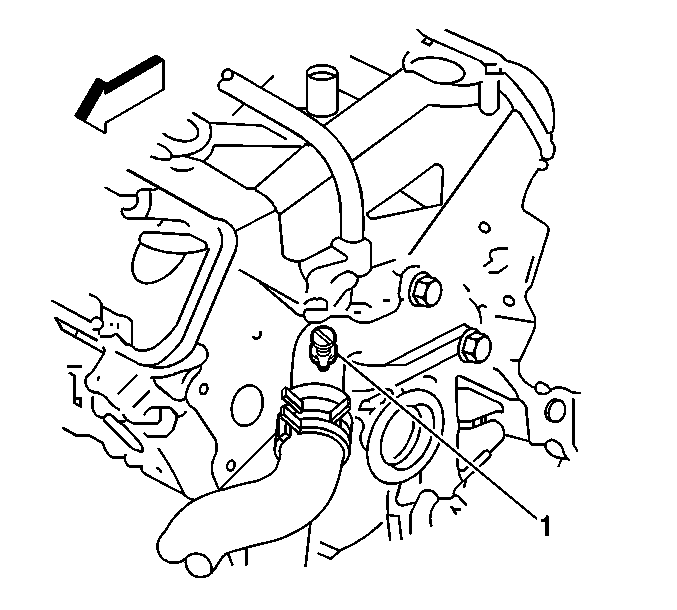
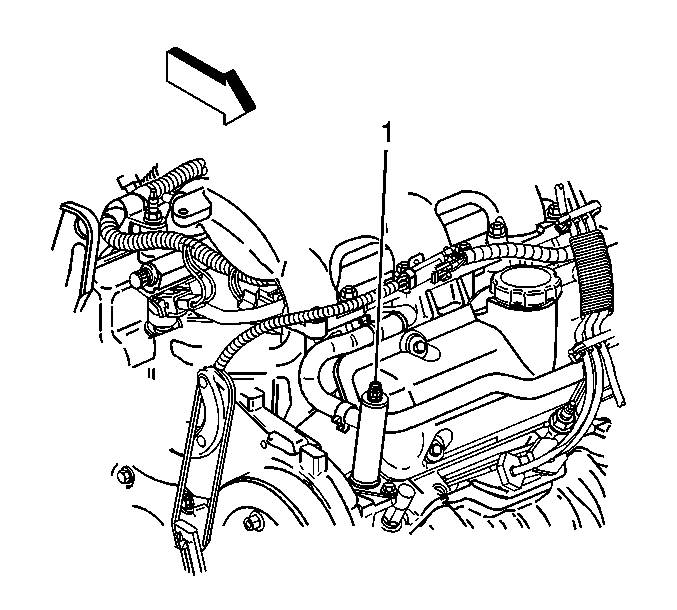
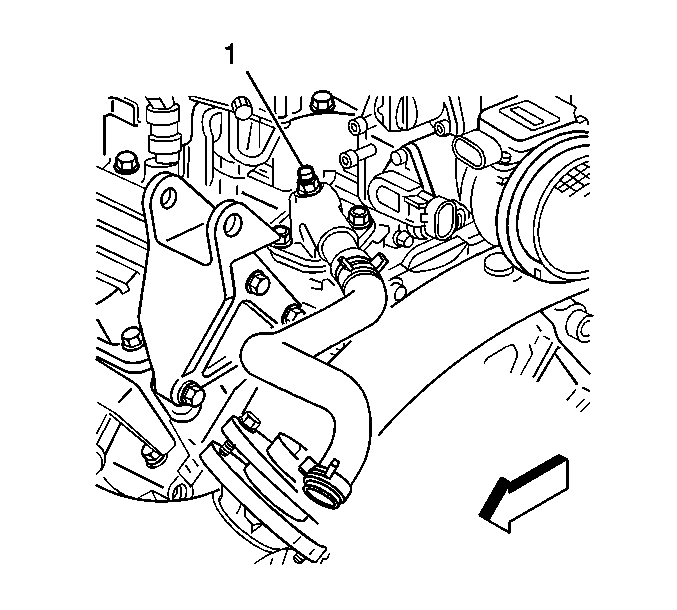
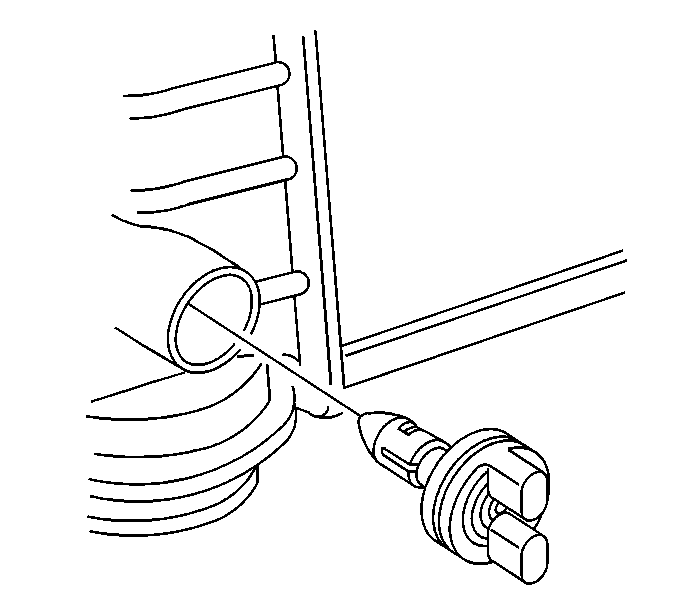
Important: For procedures requiring the cooling system to be partially drained, opening the radiator drain valve should provide sufficient draining and no further actions should be necessary.
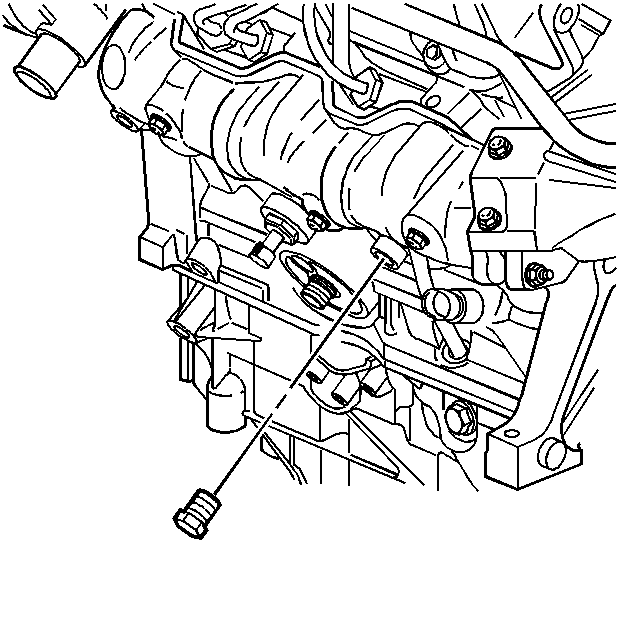
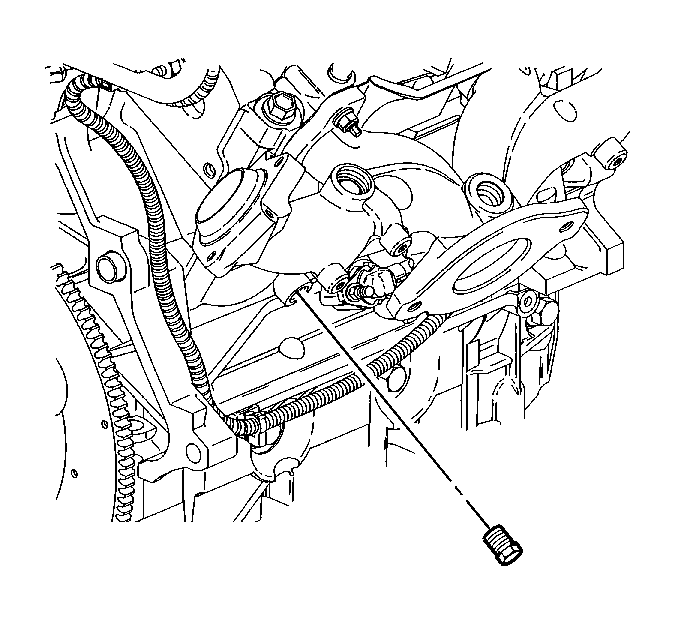

Important: Dispose of used coolant in a proper fashion. Never pour used coolant down the drain. Disposing of it into the sewer system or ground water is both illegal and ecologically unsound.
Filling Procedure
- Close the radiator drain valve.
- Install the knock sensors.
- Connect the electrical connectors to the knock sensors.
- Install the right side engine block coolant drain plug.
- Install the left side engine block coolant drain plug.
- Lower the vehicle.
- Remove the coolant recovery reservoir and empty. Flush the reservoir with clean water. Install the coolant recovery reservoir. Refer to Coolant Recovery Reservoir Replacement .
- Slowly fill the cooling system through the radiator neck using the following procedure:
- Install the radiator cap making certain the arrows line up with the overflow tube.
- Close the air bleed valve (1) on the water outlet housing 3.8L engine.
- Close the air bleed valve (1) on the thermostat bypass pipe 3.4L engine.
- Close the air bleed valve (1) on the water outlet housing 3.4L engine.
- Fill the coolant recovery reservoir to the COLD mark with of a 50/50 mixture of ethylene glycol and clean drinkable water.
- Inspect the freeze protection of the engine coolant after the engine heats up and cools down 3 times using a refractometer or a thermohydrometer to ensure proper freeze -37°C (-34°F) protection. Obtain the coolant mixture for the inspection from the base of the radiator neck, NOT from the coolant recovery reservoir.

Notice: DO NOT use cooling system seal tabs, or similar compounds, unless otherwise instructed. The use of cooling system seal tabs, or similar compounds, may restrict coolant flow through the passages of the cooling system or the engine components. Restricted coolant flow may cause engine overheating and/or damage to the cooling system or the engine components/assembly.

Notice: Use the correct fastener in the correct location. Replacement fasteners must be the correct part number for that application. Fasteners requiring replacement or fasteners requiring the use of thread locking compound or sealant are identified in the service procedure. Do not use paints, lubricants, or corrosion inhibitors on fasteners or fastener joint surfaces unless specified. These coatings affect fastener torque and joint clamping force and may damage the fastener. Use the correct tightening sequence and specifications when installing fasteners in order to avoid damage to parts and systems.
Tighten
Tighten the knock sensors to 19 N·m (14 lb ft).

Tighten
Tighten the right side engine block drain plug to 19 N·m
(14 lb ft).

Tighten
Tighten the left side engine block drain plug to 19 N·m
(14 lb ft).
Important:
• When filling the cooling system, add GM approved Ethylene Glycol
Coolant DEX-COOL GM P/N 12346290. • If the cooling system is being refilled ONLY, with out a flush,
a 50 percent ethylene glycol and 50 percent clean drinkable
water mixture should be used to fill the system. Fill the system until
the level of the 50/50 mixture has reached the base of the radiator
neck. Wait 2 minutes. Check the level of the coolant mixture. Add a
50/50 ethylene glycol/water mixture as necessary to restore the coolant
mixture level to the base of the radiator neck.
| 8.1. | If the coolant system has been flushed first add 100 percent ethylene glycol: |
| • | 3.4L Engine - 5.2 L (5.45 qt) |
| • | 3.8L Engine - 4.8 L (5.05 qt) |
| 8.2. | Slowly add clean drinkable water to the system until the level of the coolant mixture has reached the base of the radiator neck. |
| 8.3. | Wait for 2 minutes. Check the level of the coolant mixture. Add clean drinkable water if necessary to restore the coolant mixture level to the base of the radiator neck. |


Important: DO NOT over-torque the air bleed valve. The air bleed valve is made out of brass.

